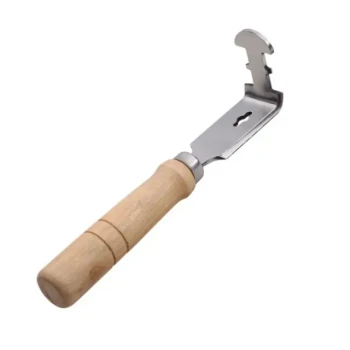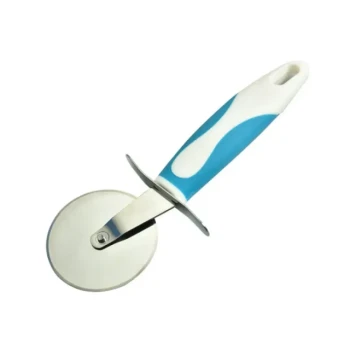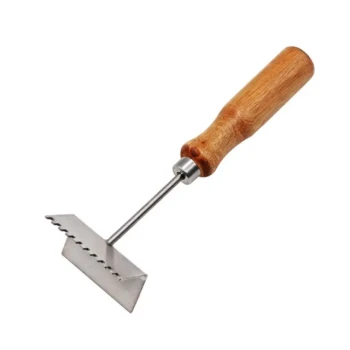Investing in a high-quality beekeeping suit is one of the most critical decisions a beekeeper can make, directly impacting safety, comfort, and confidence. The primary benefits are significantly enhanced protection from stings, superior durability for long-term use, and advanced comfort features like ventilation that allow you to work calmly and effectively, especially in hot weather.
The core decision isn't just about preventing stings; it's about investing in the confidence and focus required for effective hive management. A high-quality suit removes physical discomfort and fear from the equation, allowing you to be a better, more observant beekeeper.
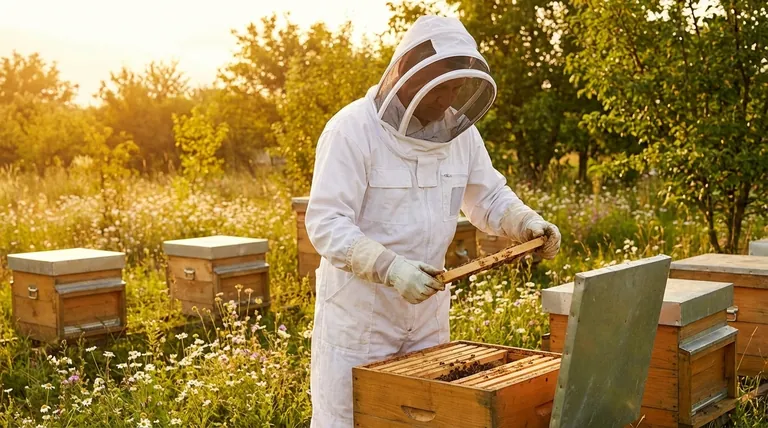
The Anatomy of a High-Quality Suit
A premium beekeeping suit is more than just a layer of fabric. Its value lies in the specific materials and design features engineered to provide a secure yet comfortable barrier between you and the colony.
Material and Construction
The suit's material is its first line of defense. Polycotton blends are common, offering a balance of protection and wearability.
However, top-tier suits often feature a triple-layer mesh construction. This design uses multiple layers of thick and fine mesh to make it nearly impossible for a bee's stinger to reach your skin while remaining surprisingly breathable.
Advanced Ventilation
Working in an apiary on a hot day can be strenuous. Fully ventilated suits are designed specifically for this challenge.
These suits allow for constant airflow across your entire body, drastically reducing the risk of overheating and allowing you to work longer and more comfortably.
Critical Design Features
Small details have a significant impact on performance. High-quality suits include robust zippers, secure elastic cuffs at the wrists and ankles, and well-designed hooded veils that offer clear visibility without compromising protection.
Key Benefits in Practice
These features translate directly into tangible advantages when you are working with your hives. Understanding these benefits helps justify the initial investment.
Superior Protection and Confidence
The most obvious benefit is reliable protection from bee stings, but it goes deeper than that. Knowing you are well-protected allows you to move with calm, deliberate confidence.
This confidence is crucial, as jerky, nervous movements can agitate a colony. A good suit helps you remain a calm presence, leading to a better experience for both you and the bees.
All-Weather Comfort
A high-quality suit protects you from more than just bees. It offers sun protection during long days and, in the case of ventilated suits, provides an escape from oppressive heat.
This level of comfort is not a luxury; it is a safety feature that prevents heat exhaustion and keeps your mind focused on the task at hand.
Enhanced Durability
A well-made suit is a long-term investment. Superior materials and reinforced stitching mean the suit will withstand frequent use, washings, and the general wear and tear of apiary work for many seasons.
Understanding the Trade-offs
No single piece of equipment is perfect for every situation. Objectively weighing the trade-offs ensures you make an informed decision.
Cost vs. Longevity
The most significant barrier to a high-quality suit is the upfront cost. However, its extended lifespan often makes it more economical over time compared to replacing cheaper, less durable suits every couple of seasons.
Weight and Bulk
Fully ventilated, multi-layer suits are exceptionally protective and cool, but they are typically heavier and bulkier than simple cotton suits. This can be a factor if you require maximum mobility or are sensitive to the extra weight.
The Critical Importance of Fit
Even the most expensive suit will fail if it fits poorly. A suit that is too tight stretches the material, reducing its protective gap and making stings more likely. A suit that is too loose can be cumbersome and get caught on equipment. Always prioritize a proper fit with adjustable features.
Making the Right Choice for Your Goal
Your specific needs, climate, and beekeeping style should guide your final decision.
- If your primary focus is occasional hobby beekeeping in a mild climate: A well-constructed polycotton suit with secure cuffs and a good veil may be perfectly adequate.
- If your primary focus is beekeeping in a hot climate or for long durations: Investing in a fully ventilated, triple-mesh suit is essential for your comfort and safety.
- If your primary focus is maximum peace of mind with aggressive colonies: Prioritize a suit with a multi-layer construction, reinforced seams, and overlapping zipper flaps.
Choosing the right protective gear transforms beekeeping from a task of endurance into a practice of focused enjoyment.
Summary Table:
| Benefit | Key Features | Ideal For |
|---|---|---|
| Superior Protection | Triple-layer mesh, robust zippers, secure elastic cuffs | Beekeepers working with aggressive colonies or seeking maximum safety |
| All-Weather Comfort | Fully ventilated design, breathable materials | Hot climates, long-duration hive inspections |
| Enhanced Durability | Reinforced stitching, high-quality polycotton blends | Commercial apiaries and frequent users needing long-term value |
Ready to equip your apiary with durable, professional-grade beekeeping suits?
HONESTBEE supplies commercial apiaries and beekeeping equipment distributors with wholesale-focused beekeeping supplies and equipment. Our high-quality suits are engineered for maximum protection and comfort, helping your team work safely and efficiently.
Contact us today to discuss bulk pricing and find the perfect protective gear for your operation!
Visual Guide
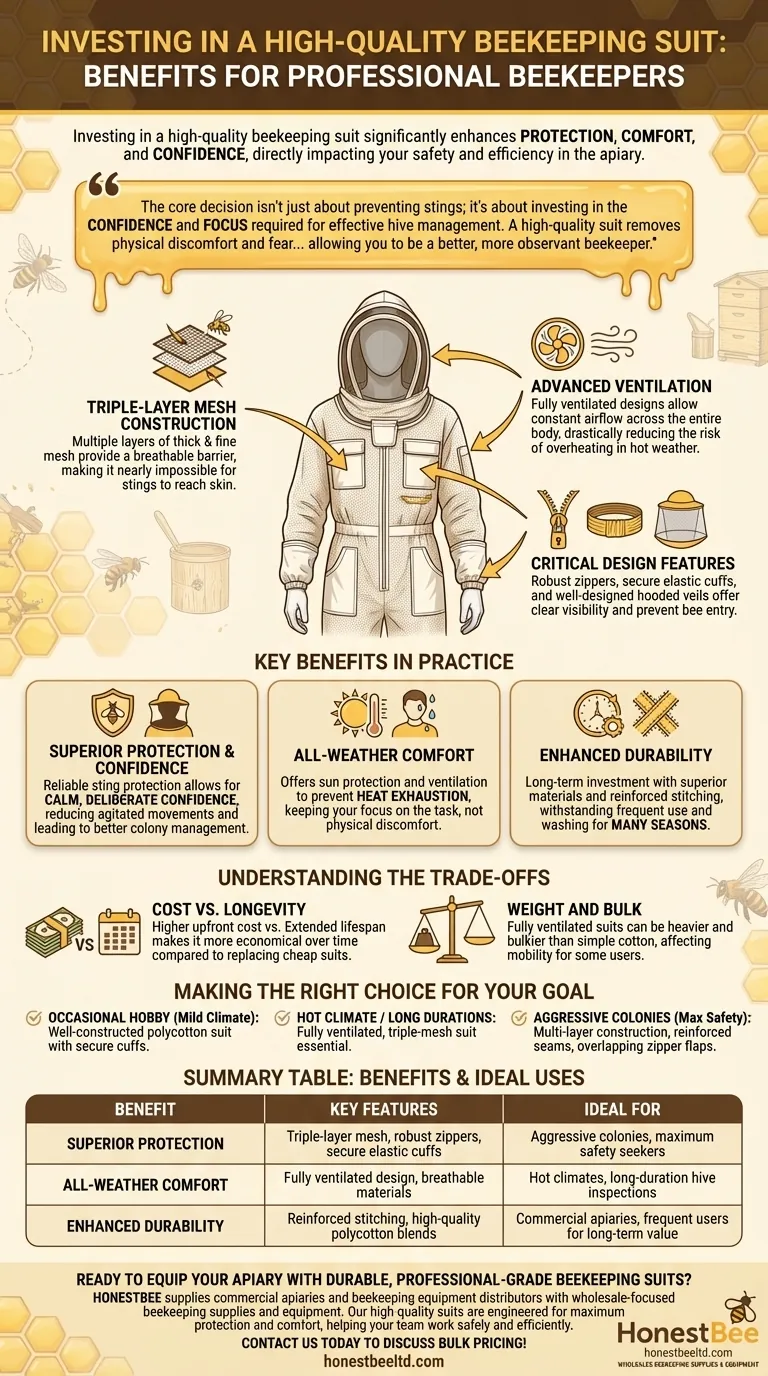
Related Products
- Cotton Beekeeping Suit and Round Hat with Veil Bee Keeper Protective Gear
- 3 Layer Mesh Vented Sting Proof Beekeeping Suit with Hat and Veil
- Vented Beekeeping Jacket with Hood and Veil for Beekeepers
- Yellow Plastic Bucket Pail Perch for Beekeeping
- Heavy-Duty Stainless Steel Clip-On Frame Perch
People Also Ask
- How should a bee suit be cleaned? Protect Your Investment and Ensure Apiary Safety
- How should a beekeeping suit be hung to maintain its shape? Protect Your Investment with Proper Storage
- What factors should be considered when choosing a beekeeping suit? Balance Safety, Comfort & Performance
- Why is white the predominant color in bee suit designs? | Key to Hive Calm & Beekeeper Safety
- What is recommended for beginners in beekeeping regarding protective clothing? A Complete Safety Guide for New Beekeepers














